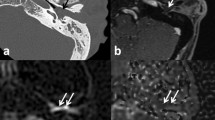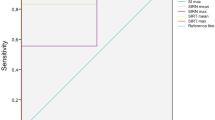Abstract
Our goal was to determine the value of echo-planar diffusion-weighted MR imaging in detecting the presence of primary acquired and residual cholesteatoma. One hundred patients were evaluated by preoperative magnetic resonance (MR) imaging with diffusion-weighted MR imaging. The patient population consisted of a first group of 55 patients evaluated in order to detect the presence of a primary acquired cholesteatoma. In the second group, 45 patients were evaluated for the presence of a residual cholesteatoma 8–18 months after cholesteatoma surgery, prior to second-look surgery. Surgical findings were compared with preoperative findings on diffusion-weighted imaging (DWI). The sensitivity, specificity, positive and negative predictive values of both groups was assessed. In the group of primary surgery patients, hyperintense signal compatible with cholesteatoma was found in 89% of cases with a sensitivity, specificity, positive and negative predictive value for DWI of 81, 100, 100 and 40%, respectively. In the group of second-look surgery patients, only one of seven surgically verified residual cases was correctly diagnosed using DWI, with a sensitivity, specificity, positive and negative predictive values of 12.5, 100, 100 and 72%, respectively. These results confirm the value of DWI in detecting primary cholesteatoma, but show the poor capability of DWI in detecting small residual cholesteatoma.



Similar content being viewed by others
References
Tierney PA, Pracy P, Blaney SP, Bowdler DA (1999) An assessment of the value of the preoperative computed tomography scans prior to otoendoscopic ‘second look’ in intact canal wall mastoid surgery. Clin Otolaryngol 24:274–276
Blaney SP, Tierney P, Oyarazabal M, Bowdler DA (2000) CT scanning in “second look” combined approach tympanoplasty. Rev Laryngol Otol Rhinol (Bord) 121:79–81
Wake M, Robinson JM, Witcombe JB, Bazerbachi S, Stansbie JM, Phelps PD (1992) Detection of recurrent cholesteatoma by computerized tomography after ‘closed cavity’ mastoid surgery. J Laryngol Otol 106:393–395
Denoyelle F, Silberman B, Garabedian E (1994) Value of magnetic resonance imaging associated with X-ray computed tomography in the screening of residual cholesteatoma after primary surgery. Ann Otolaryngol Chir Cervicofac 111:85–88
Kimitsuki T, Suda Y, Kawano H, Tono T, Komune S (2001) Correlation between MRI findings and second-look operation in cholesteatoma surgery. ORL J Otorinolaryngol Relat Spec 63:291–293
Vanden Abeele D, Coen E, Parizel PM, Van de Heyning P (1999) Can MRI replace a second look operation in cholesteatoma surgery? Acta Otolaryngol 119:555–561
Williams MT, Ayache D, Alberti C, Heran F, Lafitte F, Elmaleh-Berges M, Piekarski JD (2003) Detection of postoperative residual cholesteatoma with delayed contrast-enhanced MR imaging initial findings. Eur Radiol 13:169–174
Ayache D, Wiliams MT, Lejeune D, Corre A (2005) Usefulness of delayed postcontrast magnetic resonance imaging in the detection of residual cholesteatoma after canal wall-up tympanoplasty. Laryngoscope 115:607–610
Aikele P, Kittner T, Offergeld C, Kaftan H, Huttenbrink KB, Laniado M (2003) Diffusion-weighted MR imaging of cholesteatoma in pediatric and adult patients who have undergone middle ear surgery. AJR Am J Roentgenol 181:261–265
Fitzek C, Mewes T, Fitzek S, Mentzel HJ, Hunsche S, Stoeter P (2002) Diffusion-weighted MRI of cholesteatomas of the petrous bone. J Magn Reson Imaging 15:636–641
Maheshwari S, Mukherji SK (2002) Diffusion-weighted imaging for differentiating recurrent cholesteatoma from granulation tissue after mastoidectomy: case report. Am J Neuroradiol 23:847–849
Mark AS, Casselman JW (2001) Anatomy and disease of the temporal bone. In: Atlas SW (ed) Magnetic resonance imaging of the brain and spine, 3rd edn. Lippincott, Williams and Wilkins, Philadelphia, pp 1363–1432
De Foer B, Casselman JW, Govaere F, Vercruysse JP, Pouillon M, Somers T, Offeciers E (2002) The role of MRI and diffusion-weighted images in the diagnosis of middle ear cholesteatoma. Acta Radiol Port 14:89 (abstract)
Stasolla A, Magluilo G, Parrotto D, Luppi G, Marini M (2004) Detection of postoperative relapsing/residual cholesteatomas with diffusion-weighted echo-planar magnetic resonance imaging. Otol Neurotol 25:879–884
Martin N, Sterkers O, Nahum H (1990) Chronic inflammatory disease of the middle ear cavities: Gd-DTPA-enhanced MR imaging. Radiology 176:399–405
Ishii K, Takahashi S, Kobayashi T, Matsumoto K, Ishibashi T (1991) MR imaging of middle ear cholesteatomas. J Comput Assist Tomogr 15:934–937
Robert Y, Carcasset S, Rocourt N, Hennequin C, Dubrulle F, Lemaitre L (1995) Congenital cholesteatoma of the temporal bone: MR findings and comparison with CT. Am J Neuroradiol 16:755–761
Lansberg MG, Norbash AM, Marks MP, Tong DC, Moseley ME, Albers GW (2000) Advantages of adding diffusion-weighted magnetic resonance imaging to conventional magnetic resonance imaging for evaluating acute stroke. Arch Neurol 57:1311–1316
Van den Brink JS, Watanabe Y, Kuhl CK, Chung T, Muthupillai R, Van Cauteren M, Yamada K, Dymarkowski S, Bogaert J, Maki JH, Matos C, Casselman JW, Hoogeveen RM (2003) Implications of SENSE MR in routine clinical practice. Eur J Radiol 46:3–27
Author information
Authors and Affiliations
Corresponding author
Rights and permissions
About this article
Cite this article
Vercruysse, JP., De Foer, B., Pouillon, M. et al. The value of diffusion-weighted MR imaging in the diagnosis of primary acquired and residual cholesteatoma: a surgical verified study of 100 patients. Eur Radiol 16, 1461–1467 (2006). https://doi.org/10.1007/s00330-006-0160-2
Received:
Revised:
Accepted:
Published:
Issue Date:
DOI: https://doi.org/10.1007/s00330-006-0160-2




